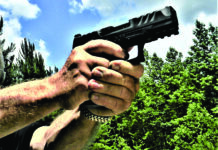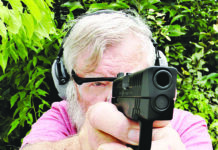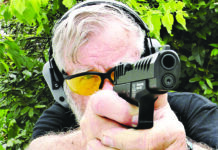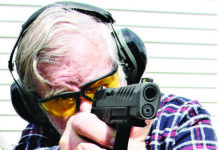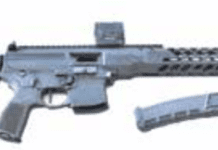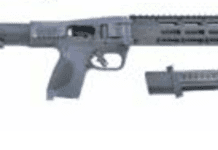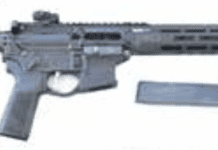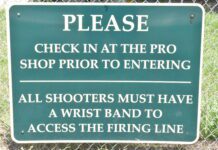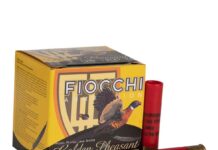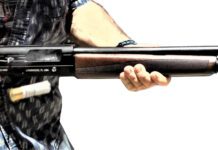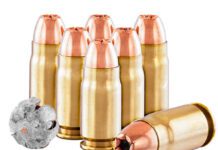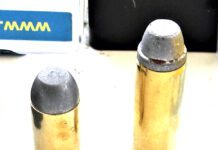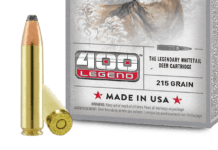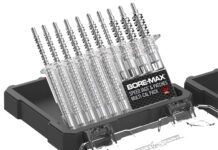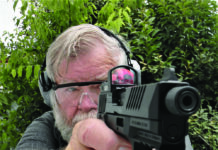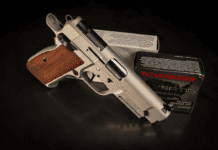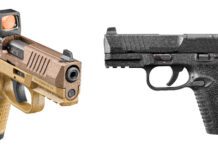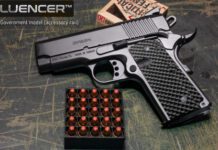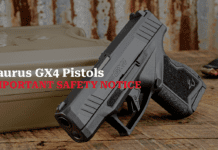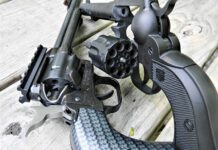Gun Tests Review: Beretta A400 Xplore 28 Gauge Shotgun
For the May 2015 issue of Gun Tests, Contributing Editor Roger Eckstine assembled a team of shooters to test a 28-gauge Beretta A400 Xplore Action semi-auto.
Unlike many other semi-automatic shotguns, including the Legacy Pointer tested against it, the Xplore Action produced very little sensation of action cycling.
The Beretta's pistol grip was fashioned with fine, consistent checkering. The extra plate and shims were for tuning the gun to the shooter. Checkering around the trigger guard was a nice touch.
28-Gauge Semi-Automatics: Legacy Sport Versus Beretta
Skeet shooting is probably the most popular of all shotgun sports, perhaps because in the opinion of many dedicated upland-bird hunters, skeet is the game that offers the most realistic preparation for a day in the field. This alone may be reason enough to play, but for anyone who has tried big-time tournament skeet shooting, finding the right equipment can lead to sticker shock. Here's why.
Skeet tournaments require at least four rounds of shooting with four different gauges of shotguns. If you've ever tried to sign up for a tournament expecting to compete in only the 12-gauge events, your entry will likely be relegated to a wait list behind all the competitors who are ready to shoot all four gauges. The serious tournament competitors must have a complete stable of shotguns, including 20 gauge, 28 gauge and .410 bore, as well as a 12 gauge. Some shooters opt to have their 12-gauge shotgun precision fit with tubes that convert the bore to fire the full list of smaller gauge rounds. But there's another way to solve the problem, and it's one that lead us to a whole new field of pleasure.
After learning that we could compete with a 20-gauge shotgun in the 12-gauge round and shoot the 20-gauge events with a 28-gauge shotgun, we decided to try shooting all but the .410 events with a 28-gauge shotgun. As a result we found out that we liked shooting 28-gauge shotguns a whole lot, specifically the semi-automatic ones. We chose to shoot a semi-automatic rather than an over-under shotgun for two reasons. First, top-quality semi-automatic shotguns are still much less expensive than many medium-priced over-under shotguns. Maybe its because less hand-craftsmanship and fitting is required. Second, we have a variety of people on staff, and semi-automatic shotguns are easier to fit. The angles of cast and drop on the semi-autos can be changed to suit each shooter quite easily with the use of shims and templates installed between the receiver and the buttstock. Furthermore, it is well known that recoil from 28-gauge ammunition is relatively mild, so fatigue or injury over the course of a long practice session is far less likely than from the effects of 12-gauge or even 20-gauge ordnance. That goes about double for the gas operated semi-automatic shotguns that bleeds pressure from ignition and dampens recoil.
The two semi-automatic shotguns we chose for this evaluation fit different ends of the price range in this category. The Turkish-made Pointer shotgun is imported by Legacy Sports International of Reno, Nevada and carries a suggested retail price of $701, but typically sells for about $650. The Pointer line of shotguns, both semi-automatic and over/under, is not to be confused with the Japanese-made Charles Daly products of the same name from several years back.
The Beretta A400 Excel Action manufacturer's suggested retail price was $1600, but we found one for $1398 MAP (Manufacturers Advertised Pricing) at the Pro Shop at American Shooting Centers in Houston (AMShootCenters.com). The Pointer was capable of chambering 3-inch as well as 2.75-inch shells, but the Beretta's barrel listed only 2.75-inch loads. Otherwise, both guns featured gas operation, walnut stocks, alloy receivers, a rubber-like butt pad, 28-inch ribbed barrel with light-gathering fiber-optic beads, crossbolt safeties, and magazine cutoffs so the bolt need not be worked to empty the gun. A selection of five flush-fit choke tubes, including Full, Improved Modified, Modified, Improved Cylinder and Cylinder bore were supplied with the Pointer shotgun. The Beretta shipped with only three: Full, Modified and Cylinder bore chokes.
12 Gauges: Browning Citori Crossover v. Franchi Instinct SL
There is an old saying that competitors should "beware the one who uses one gun," meaning that a shooter who does everything with the same shotgun probably is very familiar with how the firearm handles in a variety of shooting situations.
Knowing what that one gun can and cannot do, plus being able to repeatedly and effectively put that firearm to good use, gives a shooter the edge in both the field and on a clay target range.
In today's high-tech world, finding that all-around over and under shotgun has become increasingly difficult. Most firearms are specialized for a certain use—a target gun probably doesn't perform as effectively on game as a field gun; and field guns can't seem to match the target-busting ability of a shotgun made for clays.
A Gun Tests reader in Pennsylvania, Randy Cornman, had asked us for a head-to-head test of the "new" Ruger Red Label shotgun at $1,800 against the new Browning Citori Crossover Target with an MSRP of $2,000. He said, "It's time for a real knock-down, drag-out, head-to-head comparison. Both with 30-inch barrels, of course. We need at least 500 to 1,000 shots apiece. With all glitches detailed." Apparently, we acted too slowly to get ahead of Ruger, which we learned last month was discontinuing the Red Label line for a second time. So in its place we substituted a much less expensive Franchi Instinct SL to see if the SL could out duel its pricier counterpart. Both shotguns retail for less than $2,000 and are marketed as being able to handle duties on both birds in the field and clays at the range.
For our patterning tests of the two 12-gauge over-and-unders, we selected Winchester AA Extra-Light Target 2.75-inch loads packing 1 ounce of No. 8 shot with an average muzzle velocity of 1,190 fps. We also used the Winchesters during our field and clay target sessions, in addition to Kemen Premium Sport 2.75-inch loads with 7⁄8 ounce of No. 71⁄2 shot with an average muzzle velocity of 1,340 fps.
Both shotguns handled both types of shells in the field and on the clay target range without a hitch. As more thoroughly covered below, the felt recoil was slightly higher with both loads when shooting the lighter-weight Franchi. Here are our findings:
SxS 20-Gauge Showdown: CZ-USA and SIACE Shoot It Out
Every once in awhile, veteran shotgun enthusiasts might think back to the old days when hunting and target shooting proceeded at a slower pace, with a little more emphasis on fine form. Not that there is anything wrong with the quality over and under, semi-automatic, or pump-action shotguns on today's market, but in many minds, the old side-by-sides just give off an image of a little more class. A lot of today's veteran hunters started their shooting careers with an old double barrel handed down to them by their father or grandfather. Unfortunately, many of those old side-by-sides kicked like a mule and had so much drop in the stock that the shooter really had to work at obtaining a proper sight picture to hit anything.
Times have changed, and now the younger generation seems to have adjusted to modern technology with new model scatterguns that are easier to shoot and handle. Fine side-by-sides are few and far between on today's field and clay target ranges, but they have not been totally forgotten. We decided to jump into our time machine and take a little venture back to the days when side-by-sides were king. To cover the bases and pit old versus new within a reasonable price framework, we selected a used old-style SIACE Model 350G with double hammers and double triggers, available for about $2,000; and a recently introduced CZ-USA Ringneck hammerless with a single trigger, retailing for $1,022. Both of the doubles were 20-gauge models with screw-in internal chokes.
As most shooting instructors will point out, shooting a side-by-side can be a little more difficult to master than shooting down a single-barrel sight plane. The wider two-barrel image can be a distraction for a shooter who should be focusing on the target. If you are looking at the barrel and not the target, chances are the shot string will not be in the right place at the right time, and you'll miss.
In many cases, a shooter will slightly lift his or her head off the stock of a side-by-side when taking a shot (also related to having a wider sight plane and other design features of the double guns) causing the shot to go high. Shooting a little high is fine for flushing quail, grouse or pheasants, but can play havoc with a clay target score.
A similar shooter adjustment is required when the firearm features double triggers rather than a single trigger. When the front trigger only fires the right barrel and the back trigger only fires the left barrel, the shooter has to remember to switch from front to back to touch off two shots. With practice, this switching procedure is not a problem, but for double-trigger newbies, there is most definitely potential for confusion.
Although each of the 20-gauge double guns were designed to handle up to 3-inch shells, we decided to limit our test ammunition to lighter loads, with the understanding that increased recoil can be a major factor when shooting lighter side-by-sides. Our test ammunition included Noble Target Trap 2.75-inch loads, 2.5 dram equivalent, packing 7/8 ounce of No. 7.5 shot with an average muzzle velocity of 1,210 fps; and Federal Game 2.75-inch loads, 2.5 dram equivalent, with 7/8 ounce of No. 7.5 shot with an average muzzle velocity of 1,210 fps. The only ammunition malfunction we encountered was with a single Federal shell that had its primer seated too deep for the firing pin of either of the side-by-sides to touch off. Here are the rest of our findings:
Two Combo Guns: Savage 24V Versus Baikals Model MP94
Mossberg Announces Expansion of Texas Manufacturing Facility
Converting Old Browning Model A-5s
Winchester Expands Blind Side Waterfowl Lineup for 2014
TriStar Releases New Raptor ATAC Turkey Shotgun
Benelli Super Nova Tactical No. 29155 Pump-Action 12 Gauge, $559
We compared four 12-gauge pumpguns in in the October 2013 issue. They were the Benelli Super Nova Tactical No. 29155 pump-action 12 Gauge, $559, and the recently introduced Stevens Model 320 Home Defense No. 19495, $270; the CZ Model 612 Home Defense No. 06520, $290; and the CZ Model 612 HC-P No. 06510, $349.
At a reader's request, we selected several new models of self-defense shotguns that carry low to moderate price tags and pitted them against one of the popular veteran self-defense shotguns to see how they would perform.


